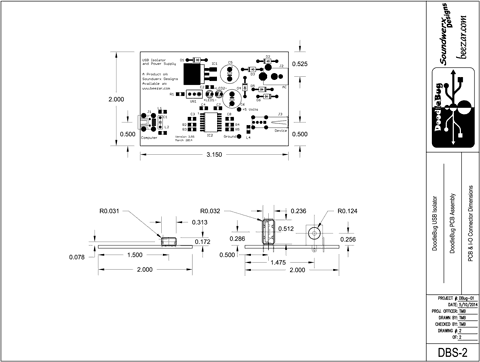mcandmar
500+ Head-Fier
- Joined
- Jul 5, 2013
- Posts
- 622
- Likes
- 108
For those following this thread here is the difference i measured using a Doodlebug. I think the noise floor is a limitation of the sound card i was using to measure the results.



I'll continue to report on the progress - hopefully, it won't be too many more weeks before we have kits available.
Hi, why does pupDAC pick up so much noise compared to skeletonDAC?

- It depends on how much noise already exists on the particular PC USB buss.
- It's a much more sensitive, detailed DAC. Some of the noise is masked by the lower-grade chip in the SkeletonDAC
- The output opamp in the PupDAC is one of the finest low-voltage opamps on the market. Strictly speaking, it's not there for amplification, but for combining the balanced output of the DAC chip into a single-ended output. Nevertheless, it's going to amplify every detail. If that detail is noise, it's going to get amplified, too There's probably more going on with the balanced-to-single-ended conversion, too, but I'm not knowledgeable enough about that to explain it.
- Another way to look at it, is that the potential of the PupDAC is much, much higher. It just needs a reasonably good environment to ensure the best performance.
In my case, the power supply of my testing environment is probably as bad as it could get and still provide operation (Acer Netbook running Windows XP). I have wondered for years why my RMAA tests were noisier, sometimes going as far as depending on other people to test Beezar products (dsavitsk, cetoole, cobaltmute, Linux-works of Arduino fame). As mentioned previously, AMB once suggested that my cables were picking up extraneous noise in my environment, etc. The entire exercise in testing the DoodleBug has proven what's really happening.
Anyway, in an environment other than the Acer Netbook, you will see a much better base performance for the PupDAC without the DoodleBug. I would still recommend the DoodleBug for any USB-powered audio device, though.
- It depends on how much noise already exists on the particular PC USB buss.
- It's a much more sensitive, detailed DAC. Some of the noise is masked by the lower-grade chip in the SkeletonDAC
- The output opamp in the PupDAC is one of the finest low-voltage opamps on the market. Strictly speaking, it's not there for amplification, but for combining the balanced output of the DAC chip into a single-ended output. Nevertheless, it's going to amplify every detail. If that detail is noise, it's going to get amplified, too There's probably more going on with the balanced-to-single-ended conversion, too, but I'm not knowledgeable enough about that to explain it.
- Another way to look at it, is that the potential of the PupDAC is much, much higher. It just needs a reasonably good environment to ensure the best performance.
In my case, the power supply of my testing environment is probably as bad as it could get and still provide operation (Acer Netbook running Windows XP). I have wondered for years why my RMAA tests were noisier, sometimes going as far as depending on other people to test Beezar products (dsavitsk, cetoole, cobaltmute, Linux-works of Arduino fame). As mentioned previously, AMB once suggested that my cables were picking up extraneous noise in my environment, etc. The entire exercise in testing the DoodleBug has proven what's really happening.
Anyway, in an environment other than the Acer Netbook, you will see a much better base performance for the PupDAC without the DoodleBug. I would still recommend the DoodleBug for any USB-powered audio device, though.
Wouldn't you subtract out the noise with balanced? If you have balanced outputs than you can subtract the noise before single ended output(like a differential signal line). Since you have two set of signal lines, noise will be the same for each set of signal lines, and you can phase shift 180 and take the sum of the sets of signal lines, and take out the noise. All amps amplify noise, but some have better SNR, no?
So, I don't really understand why the single ended will have noise at the output if the balanced amps are picking up that much noise if differential mode is implemented.
Well, the doodlebug is suppose to take out PS noise. How is the noise from amp related to PS noise?


I think Tom is still waiting on the prototype cases from Hammond.
There is also the laser etching to prototype and approve.
Should be soon.
Boards and most kit parts are ready. I think there were a couple
items that were back ordered.

Yep - exactly. I am awaiting Hammond's prototype case (1455C801) that's been machined for the DoodleBug. Once I have that - and build one using the production board - we'll be ready to go. Hopefully, I'll have the website done by then, too. So ... not too much longer - I hope.
